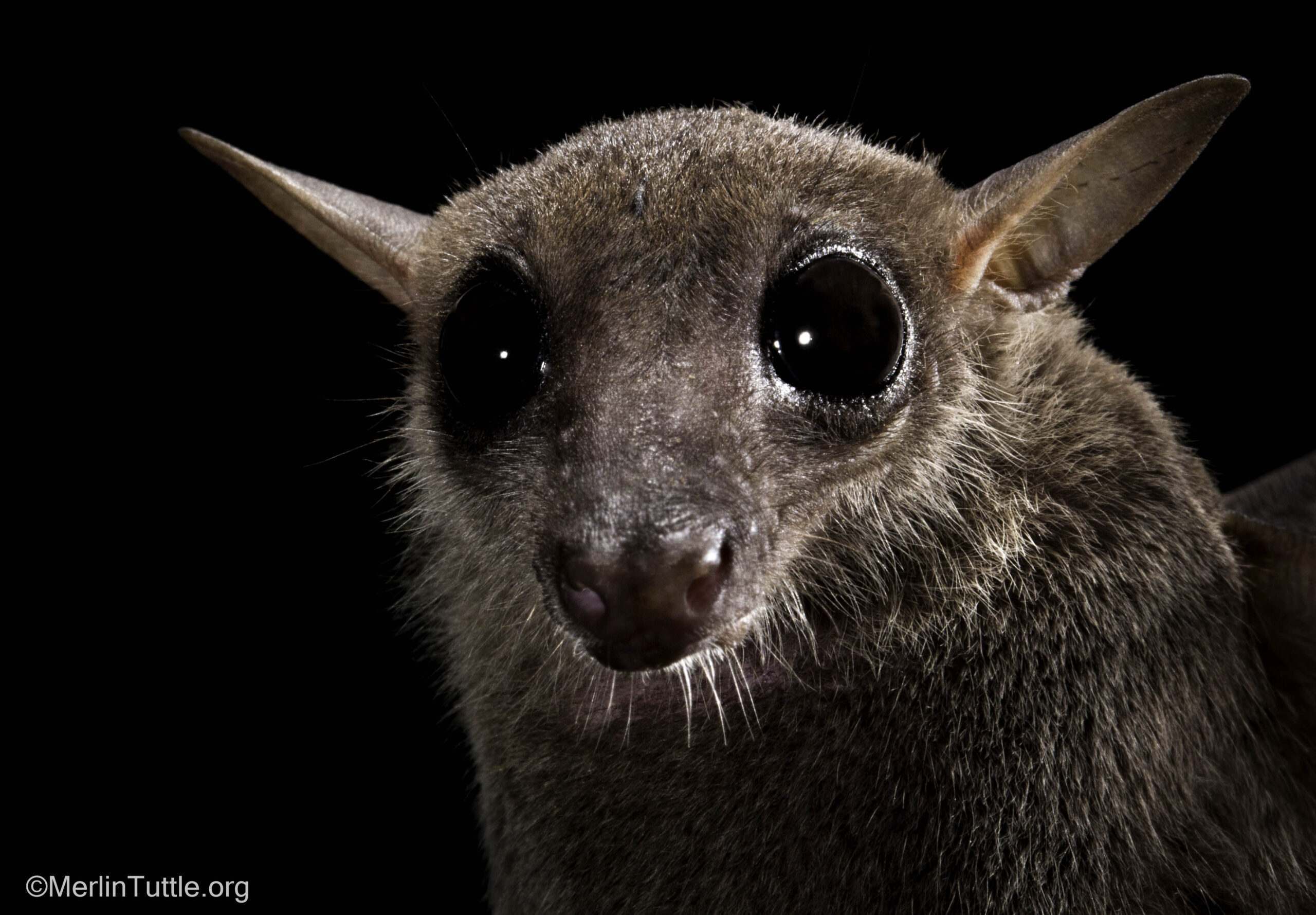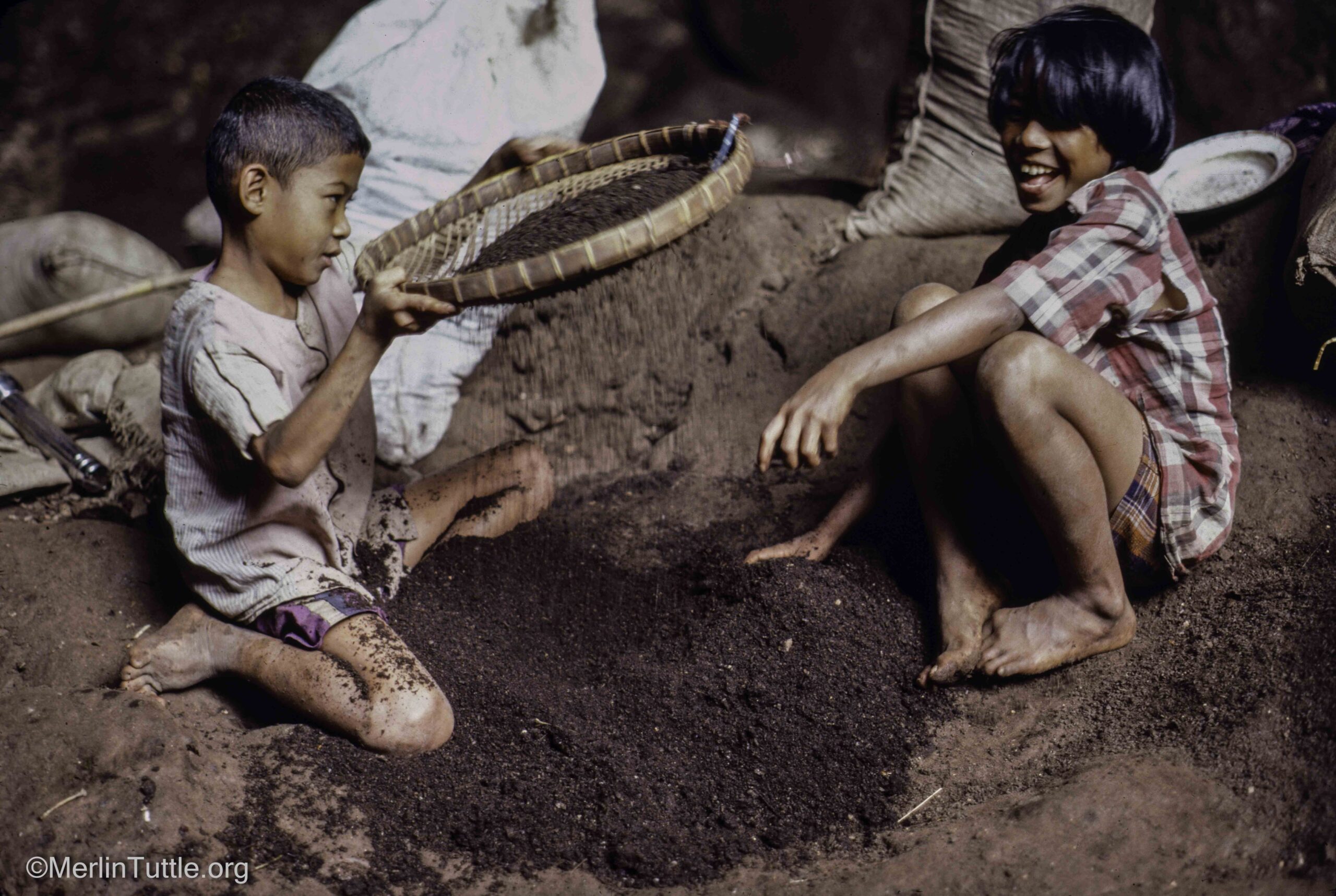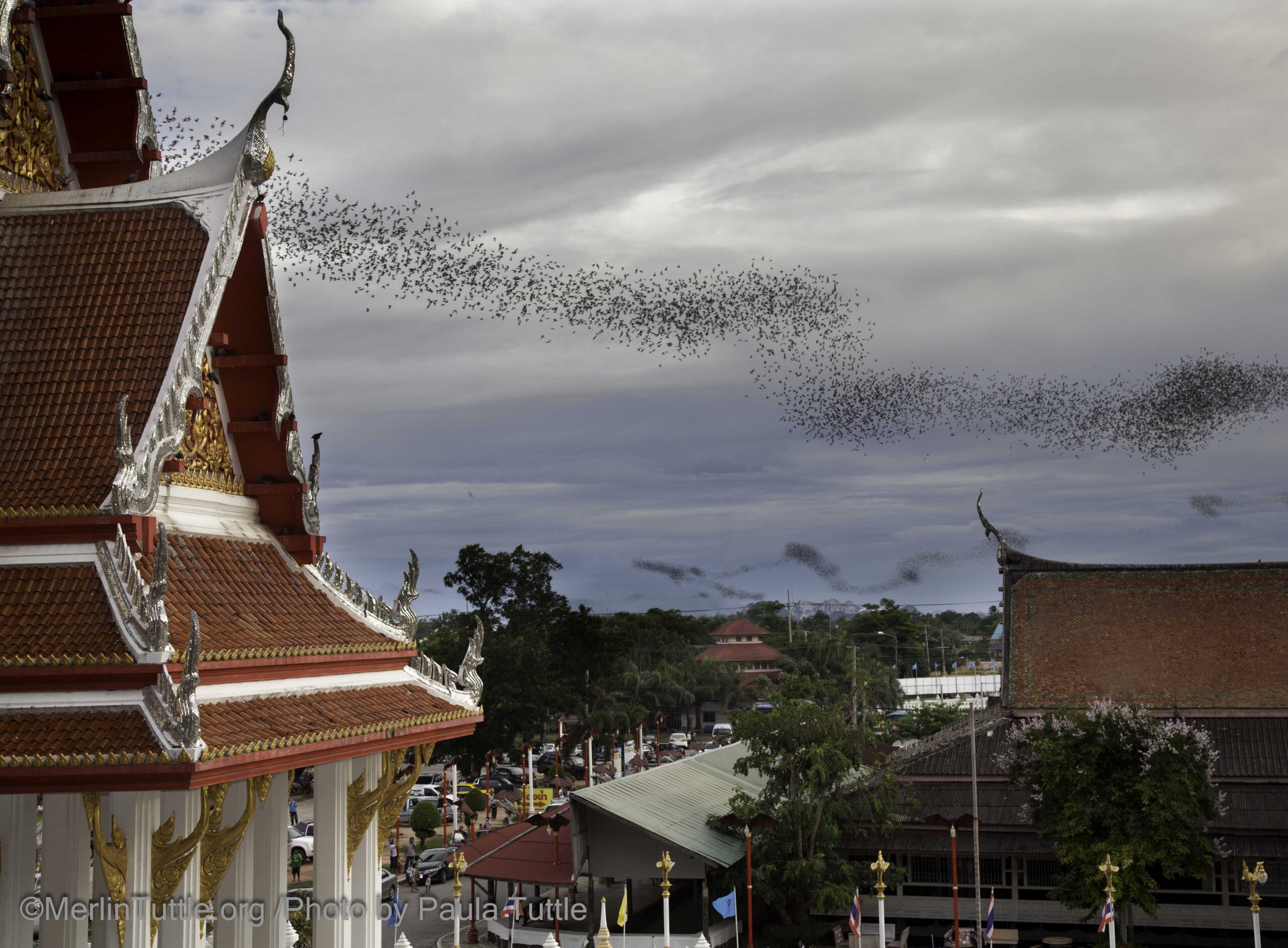Challenging torrential rains countered by cooperative bats in Costa Rica
Merlin and MTBC team members spent 19 days in Costa Rica last November on a filming trip for “Bat City” with its Director and Emmy
Craning my neck, I shone my headlamp at the cave ceiling above. I was nestled between two boulders with giant cockroaches for company and bats streaming by overhead. Flying with speed and agility, they were little more than flickering streaks of fur illuminated briefly in the darkness. Teresa called up to me, telling me to point my light higher. I couldn’t help but laugh as I realized what that would mean.
I’d been warned that the cave would be messy, the inevitable result of millions of bats making it their home, and I’d chosen to wear a wide-brimmed hat to protect against excretions from above. Tilting my head further back to shine my light at the right angle, I momentarily lost the protection afforded by said hat. I could’ve taken my headlamp off and shone it by hand instead, but truthfully, I didn’t mind the risk of looking up. The bats above me whirled with a frantic elegance most people will only ever see in a nature documentary. I hope I never forget what it was like to see it firsthand. Awestruck, I committed the scene to memory before wisely covering my eyes and mouth.
We were inside the main body of Khao Chong Pran Cave, having been granted access with the guano collectors who harvest there every Saturday morning. I was perched near the top of a mound of boulders that rose high above the cave floor. Teresa was directing me and a few others to backlight shots of Merlin.
The shots were for an upcoming educational documentary, to be produced by leading cinematographer, Skip Hobbie – made in partnership with MTBC and the Texas Parks & Wildlife Foundation. The short film will be about the beauty and importance of bats worldwide, as well as the history of Merlin’s conservation successes in Austin and beyond. The team had been working tirelessly on shots during our stay in Ratchaburi. After all the bats had done for us, it was a no brainer to return the favor.
The journey to the main cavern began earlier in the Khao Chong Pran temple courtyard. A nondescript, albeit somewhat foreboding, concrete doorway had been carved into the base of the hill beside the temple. Beyond the threshold lay another yawning cavern. This time, I hardly hesitated before venturing underground.
I quickly learned that Khao Chong Pran Cave was not like the others we’d visited. My senses were assaulted as soon as I made it through the door. The temperature rose so fast I began to sweat immediately, and my clothes were drenched before we’d moved past the first chamber. The pungent fumes from the guano were sharp, acidic, and inescapable, even through the mask I had chosen to wear to try to protect against the smell.
With effort, I tuned myself back into the world around me. A series of whooshing and clicking noises, like static electricity, echoed nearby. As we rounded a corner, I learned that this was the sound of droves of bats flying from room to room and chittering from the walls. Where we’d visited previous caves by day and seen small, disparate groups of bats, our visit to Khao Chong Pran coincided with a period of peak activity as millions of bats returned from their nighttime foraging.
Eventually, the path we were taking sloped upwards, gradually at first before becoming intimidatingly steep. The cave floor was slick with guano, which made both the uphill climb and the inevitable descent considerably more difficult than hiking on dry ground. I was so focused on carefully placing my feet, I didn’t notice the new cavern around me until I reached the top of the climb and could safely take my eyes off the floor.
When I did, I saw that the cave had opened into an expansive central chamber. The ceiling stretched above like a cathedral, vaulted and grand. The full power of my headlamp could only just brush the far end of the cavern, and the space between was a whirlwind of returning bats.
They flew throughout the cave with masterful precision, hundreds at a time entering from the cave mouth and splitting off into a variety of chambers. I felt like I was watching the animal kingdom’s equivalent of a busy freeway interchange. Pockets of different species were clumped together on the walls. A cluster of cave nectar bats (Eonycteris spelaea) were easily identifiable by the way their large eyes reflected light. Theobald’s tomb bats (Taphozous theobaldi) and Pomona roundleaf bats (Hipposideros pomona) populated other parts of the caverns, while countless thousands of Asian wrinkle-lipped bats (Chaerephon plicatus) whirled above and blanketed the walls like moss.

It may seem like an odd place to feel at ease, with bats streaking overhead and cockroaches crunching underfoot, but the commotion aside, it was wonderfully serene. There was nothing to fear. And, while I was just a visitor to the cave, the guano collectors at work around us had safely made a living there for decades.
We took care not to interrupt the guano collectors or frighten the bats, carefully navigating around the large piles of guano the workers had set aside, using small brushes and pans. The work they were doing might seem tedious, but it was amazing to watch them in action. They required little in the way of equipment. Aside from a headlamp, many of them were not wearing much besides a t-shirt, shorts, and flip flops. Once a heap of guano was ready, they would fill a large burlap sack and carry it down the slippery pathway to the temple grounds.

They were experts at navigating the caverns. I recall looking down a vertical passageway to find a guano collector some distance below me. To climb out of there in sandals, let alone with a large bag full of guano, was an astonishing feat of athletics.
From their comfort while being surrounded by countless flying bats, to the financial value of their harvest, the guano collectors at Khao Chong Pran exemplified both the ease and benefits of living in harmony with bats. Collectors who have been working in the cave for many decades did not need layers of protective equipment and masks that some virologists have insisted are necessary to protect against disease. Despite scary media warnings of supposedly deadly disease risks, guano collectors work weekly in the cave without harm. Profits from the harvest provide a reliable income reported to sell for approximately 200,000 U.S. dollars annually. Much of the infrastructure surrounding Khao Chong Pran has been made possible from guano sales and bat-watching tourism, and millions of bats have recovered due to Merlin’s advice and continued guidance since 1981. The Khao Chong Pran experience provides an ideal example of how the dangers of being near bats have been exaggerated.
Later that day, after bidding farewell to the caverns, we returned to the temple courtyard to watch the emergence one last time. Being a Saturday, the grounds were the busiest we’d seen them. Marie Martinek and I were approached by a German tourist, asking where he could find the “flying mouse,” the literal translation of “bat” from German to English. We pointed him towards the large bat statue that marked where to watch the emergence. As he departed, I wondered how many other tourists there that evening had come from afar to see the spectacle of Khao Chong Pran’s bats.
Shortly after 6:30 pm, streams of bats began pouring out of the cave mouth located partway up the hill behind the monastery. The column was tight-knit and winding, such that it looked like a river in the sky. Music from the Lunar New Year celebrations was blasting through speakers, and sometimes the column of bats seemed to pulse in time with the music. After several minutes of watching, I couldn’t help but think it was reminiscent of a heartbeat, a major artery thrumming with a pulse. Having seen firsthand the value of Khao Chong Pran’s bats, it seems a fitting analogy.
The bats are an integral part of the prosperity and well-being of the community. Thanks to decades of attention and care, they are thriving, and the people of Khao Chong Pran have clearly benefited as a result. Living in this kind of harmony with bats is neither far-fetched nor complicated. It simply requires a bit of understanding.
Since coming home from MTBC’s Thailand trip, I’ve had a few people react with surprise when I explain that it was all about bats. Twice, I’ve had people shake their heads at me incredulously. Each of these moments has been an opportunity: to find out what they know, to share what I’ve learned, and just maybe win over one more friend for bats. It’s not always easy and I’m not always successful, but I will keep trying. Even when we have been quite harsh to them, bats have remained invaluable to us. For that, I owe them that much.

Love our content? Support us by sharing it!
Merlin and MTBC team members spent 19 days in Costa Rica last November on a filming trip for “Bat City” with its Director and Emmy
“Just like the old days, eh Heather?” Kent softly clicks his tally counter as he sits in his folding chair on the other side of
Bats can use sounds in many complex ways. They can sing and even have different dialects… When imagining a bat, the first thoughts that come
It was a long road to Austin, Texas. More than five years after my first introduction to Merlin Tuttle’s Bat Conservation as a teenager, I packed
2024 © Merlin Tuttle’s Bat Conservation. All rights reserved.
Madelline Mathis has a degree in environmental studies from Rollins College and a passion for wildlife conservation. She is an outstanding nature photographer who has worked extensively with Merlin and other MTBC staff studying and photographing bats in Mozambique, Cuba, Costa Rica, and Texas. Following college graduation, she was employed as an environmental specialist for the Florida Department of Environmental Protection. She subsequently founded the Florida chapter of the International DarkSky Association and currently serves on the board of DarkSky Texas. She also serves on the board of Houston Wilderness and was appointed to the Austin Water Resource Community Planning Task Force.
Michael Lazari Karapetian has over twenty years of investment management experience. He has a degree in business management, is a certified NBA agent, and gained early experience as a money manager for the Bank of America where he established model portfolios for high-net-worth clients. In 2003 he founded Lazari Capital Management, Inc. and Lazari Asset Management, Inc. He is President and CIO of both and manages over a half a billion in assets. In his personal time he champions philanthropic causes. He serves on the board of Moravian College and has a strong affinity for wildlife, both funding and volunteering on behalf of endangered species.